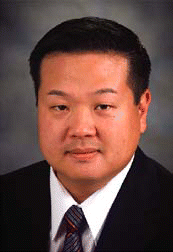The targeted therapies erlotinib and cetuximab, in combination with standard chemotherapy regimens, are well tolerated and have very encouraging activity in recurrent/metastatic head and neck squamous cell carcinoma, according to two presentations at the American Society of Clinical Oncology (ASCO) 2007 Annual Meeting in Chicago.
Explore This Issue
February 2008Interrupting the epidermal growth factor receptor (EGFR) signaling pathway has shown promise in a variety of cancers, and preclinical data have demonstrated possible synergy with platinums and taxanes, said Edward S. Kim, MD, Assistant Professor of Thoracic/Head and Neck Medical Oncology at the University of Texas M. D. Anderson Cancer Center in Houston. Treatment options for recurrent/metastatic head and neck squamous cell carcinoma are limited.
An M. D. Anderson study of cisplatin and docetaxel showed a response rate of 40% and median survival of 9.6 months. Erlotinib, an EGFR tyrosine kinase inhibitor, had a 4.3% response rate as a single agent in head and neck squamous cell carcinoma. Because of the possible synergy and efficacy, we proposed to study the combination of cisplatin, docetaxel, and erlotinib in advanced head and neck squamous cell carcinoma, Dr. Kim said.
In this open-label, Phase II trial, patients were required to have adequate performance status, measurable disease, and no prior EGFR therapy, and may have received prior induction, concomitant, or adjuvant chemotherapy, but not for recurrent/metastatic disease. Sites of disease included squamous cell head and neck sites excluding nasopharynx.
Treatment included docetaxel at 75 mg/m2 and cisplatin at 75 mg/m2, given intravenously every three weeks for up to six cycles and erlotinib at 150 mg, given orally, daily until progression. All agents were started on the first day, and patients were treated with growth factor support.
The trial has completed accrual of 50 patients, and 47 patients, median age of 57, were available for analysis. The majority had an Eastern Cooperative Oncology Group performance status of 1 (41 patients). Most patients (63%) had locoregional disease. The patients were predominantly smokers, with more than 75% being current or former smokers.
Prior therapy included radiation alone in four patients, surgery and radiation in 20, chemotherapy and radiation in five, and chemotherapy, radiation, and surgery in 13 patients. Six patients were untreated.
Complete responses have been observed in four patients (8%), partial responses in 28 patients (58%), and 13 patients (25%) have stable disease, for an overall response rate of 66% and a disease control rate of 91%. Only three patients had disease progression after two cycles of treatment.
After a follow-up of 19 months, median overall survival was 11 months and progression-free survival was six months. Our one-year survival, of note, is 48 percent, Dr. Kim said.
The study also found that 25 patients had recurrent disease in a prior irradiated field. Of these, three achieved a complete response (12%) and 11 patients (44%) had a partial response.
The most common grade 3/4 toxicity was neutropenia (64%), but only 10% of patients had febrile neutropenia. Another 14% of patients had anemia. Dehydration, nausea, vomiting, and skin toxicity were the most common nonhematologic toxicities.
This is the first study to report use of the EGFR tyrosine kinase inhibitor erlotinib combined with chemotherapy in incurable head and neck cancer, Dr. Kim said. There is encouraging efficacy, including a 66% response rate, 11-month median survival, six-month progression-free survival, and 48% one-year survival.
There is a proposed Phase II randomized study to compare docetaxel plus cisplatin versus docetaxel plus cisplatin and erlotinib, he said. We need to consider testing an active regimen such as this in chemo-naïve patients in the neoadjuvant or induction settings.
Cetuximab + Weekly Paclitaxel
In the second study, the combination of cetuximab and weekly paclitaxel was also well tolerated and provided encouraging activity in advanced/recurrent squamous cell carcinoma of the head and neck.
More than half of all newly diagnosed cases of squamous cell carcinoma of the head and neck are not cured and will relapse locally or at distant sites, noted Ricardo Hitt, MD, of the Medical Oncology Service at University Hospital 12 de Octubre in Madrid. Median survival is less than six months, and the survival rate has not changed in the past 20 years.
Cetuximab and paclitaxel have shown to be active in squamous cell carcinoma of the head and neck. Preclinical data have demonstrated a possible synergy for the combination. In a variety of tumor types, weekly paclitaxel has demonstrated an improved safety profile and activity as compared with a schedule of every three weeks paclitaxel, providing the rationale to study the combination of cetuximab and weekly paclitaxel in metastatic/recurrent squamous cell carcinoma of the head and neck.
To explore this combination as front-line treatment for this disease, the Spanish Head and Neck Group initiated a Phase II trial. Patients enrolled may have received one regimen of induction and/or concomitant chemotherapy, but not within the recurrent/metastatic setting. Treatment included weekly paclitaxel at 80 mg/m2 and cetuximab at an initial dose of 400 mg/m2, followed by a weekly infusion of 250 mg/m2.
Biopsies of tumors and samples of blood were analyzed for correlative markers, including EGFR, gene copy number using fluorescence in situ hybridization (FISH), polymorphisms of intron 1 of the EGFR, and downstream EGFR pathway markers and mutations.
A total of 46 patients, median age 59, were enrolled from April to September 2006, and 42 patients were evaluable for response. About half of the patients had locoregional recurrence, one quarter had metastatic disease, and another one quarter had recurrent and metastatic disease.
All but nine of the patients had had previous chemotherapy or radiotherapy.
The complete response rate was 60%, with 24% achieving a complete response. Disease control was observed in 88% of the patients, with responses observed in both patients with locoregional recurrence and those with distant disease.
The median progression-free survival time was five months, and time to progression was six months. After a median follow-up of six months, seven patients are alive, and currently six of the seven are receiving treatment. Overall survival has not been reached.
The median number of cycles of cetuximab (15.5) and paclitaxel (14) administered was similar.
A total of 44 patients were evaluable for safety. Only one had Grade 3/4 febrile neutropenia. Neurologic toxicities were observed in three patients, severe rash in 11, and infusion-related reaction in three. No dose effect was observed.
Translational research using FISH found no relationship between response, survival, and gene amplification. Only three patients had positive FISH with a different type of response.
EGFR expression was positive in all patients. However, there was no relationship between EGFR expression and response, survival, or FISH.
We found a positive correlation between rash and response. There was no severe rash in patients with progressive disease, he said.
In conclusion, Dr. Hitt said that the combination of cetuximab and paclitaxel used in this study was feasible and associated with very encouraging activity in the first-line treatment of patients with recurrent and/or metastatic squamous cell carcinoma of the head and neck.
Biologic markers, such as FISH analysis, do not seem to predict efficacy to this treatment combination. Further analysis of potential predictive factors or combinations of them is ongoing.
These results suggest that cetuximab and paclitaxel may play an important role for patients with recurrent head and neck cancer. Randomized trials are warranted, Dr. Hitt said.
The discussant for the study, Marshall Posner, MD, Medical Director of the Head and Neck Oncology Program at Boston’s Dana-Farber Cancer Institute, commented, Dr. Hitt’s study has a fairly impressive complete response rate of 24 percent. Unfortunately, the data are a little early, so progression-free survival, although five months, is really premature.
Notably, the toxicity was modest for a palliative regimen except for rash, which is of course a marker of response to cetuximab. But neutropenia and rash appeared to be manageable on this weekly regimen. It seems then that the bedside test of rash remains the best predictor of disease control.
Dr. Kim’s study established a maximum total dose for the combination of erlotinib, docetaxel, and cisplatin, Dr. Posner said in his discussant’s remarks. Again, there was a low complete response rate of 8 percent, but the overall response rate was an impressive 66 percent. There was also an impressive median survival, with progression-free survival of six months, and, notably, 48 percent of patients were alive at one year. Except for neutropenia, toxicity was mild for an every-three-week regimen.
Researchers should think strongly about combination therapies with cytotoxic and targeted agents, he said. Cetuximab and erlotinib have single-agent activity. Cetuximab arguably has greater activity in Phase II single-agent trials than erlotinib does. Cetuximab activity is additive with cisplatin. There are no solid data with taxanes for either agent.
Both studies show increased response rates compared with historical controls of roughly 60%, Dr. Posner continued. Paclitaxel and docetaxel as single agents show response rates of 30%, and docetaxel-cisplatin combinations show response rates in the 40% range. Cisplatin as a single agent produces a response rate of 10% to 15%. Cetuximab as a single agent has a 10% to 14% response rate and, in combination with cisplatin, 25%. From a historical point of view, these agents appear to be better than doublets or singlets, he said.
Randomized trials will be necessary to compare combination therapies with targeted agents. I believe a crossover design should be used to estimate the real impact on survival. For palliation, toxicity and progression-free survival are major considerations for patients.
The clinical assessment of rash still remains the best predictor of benefit with cetuximab. It would be very important to identify other prognostic factors to help us to determine who might benefit from the use of cetuximab, Dr. Posner said.
©2008 The Triological Society


Leave a Reply